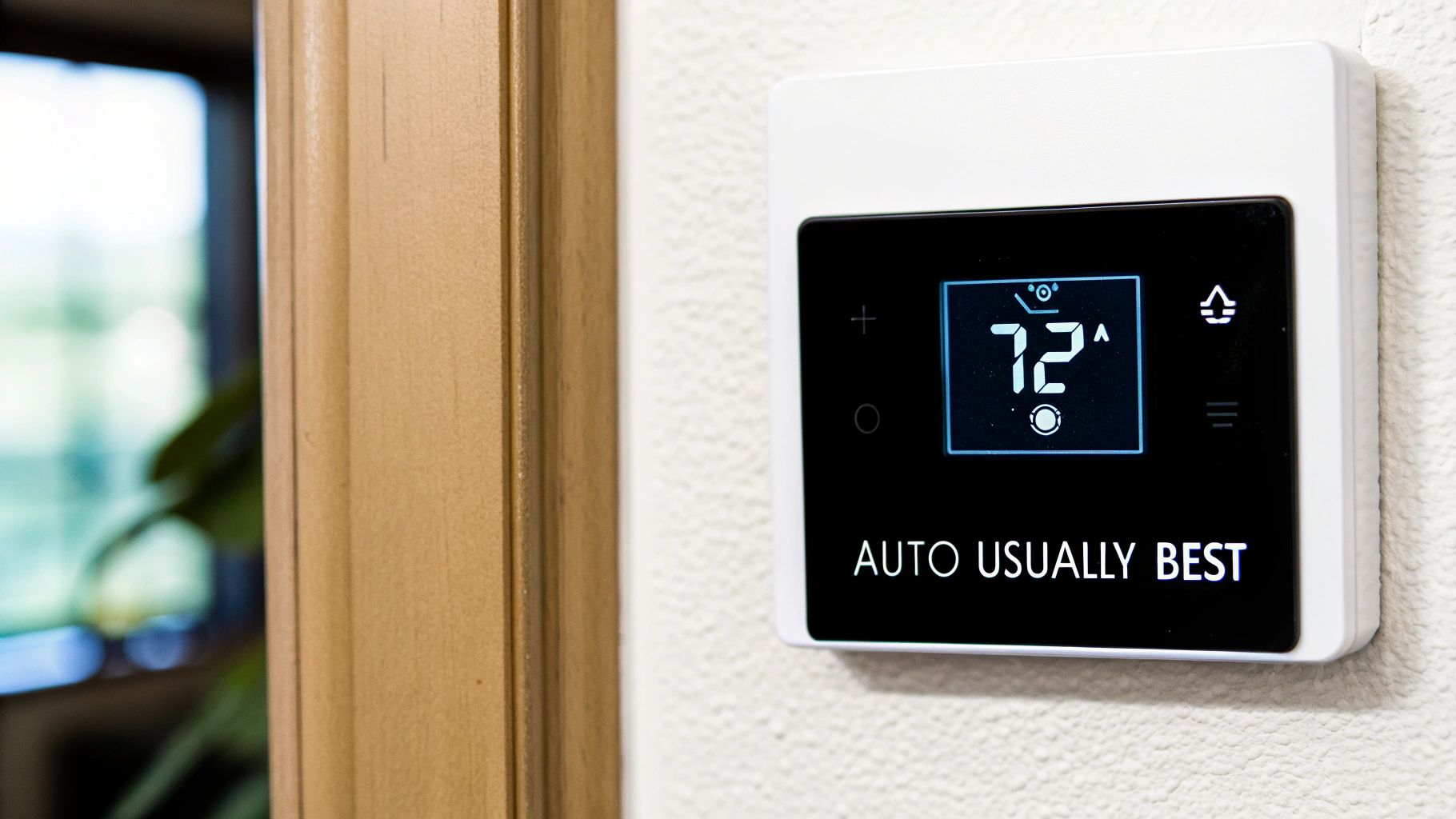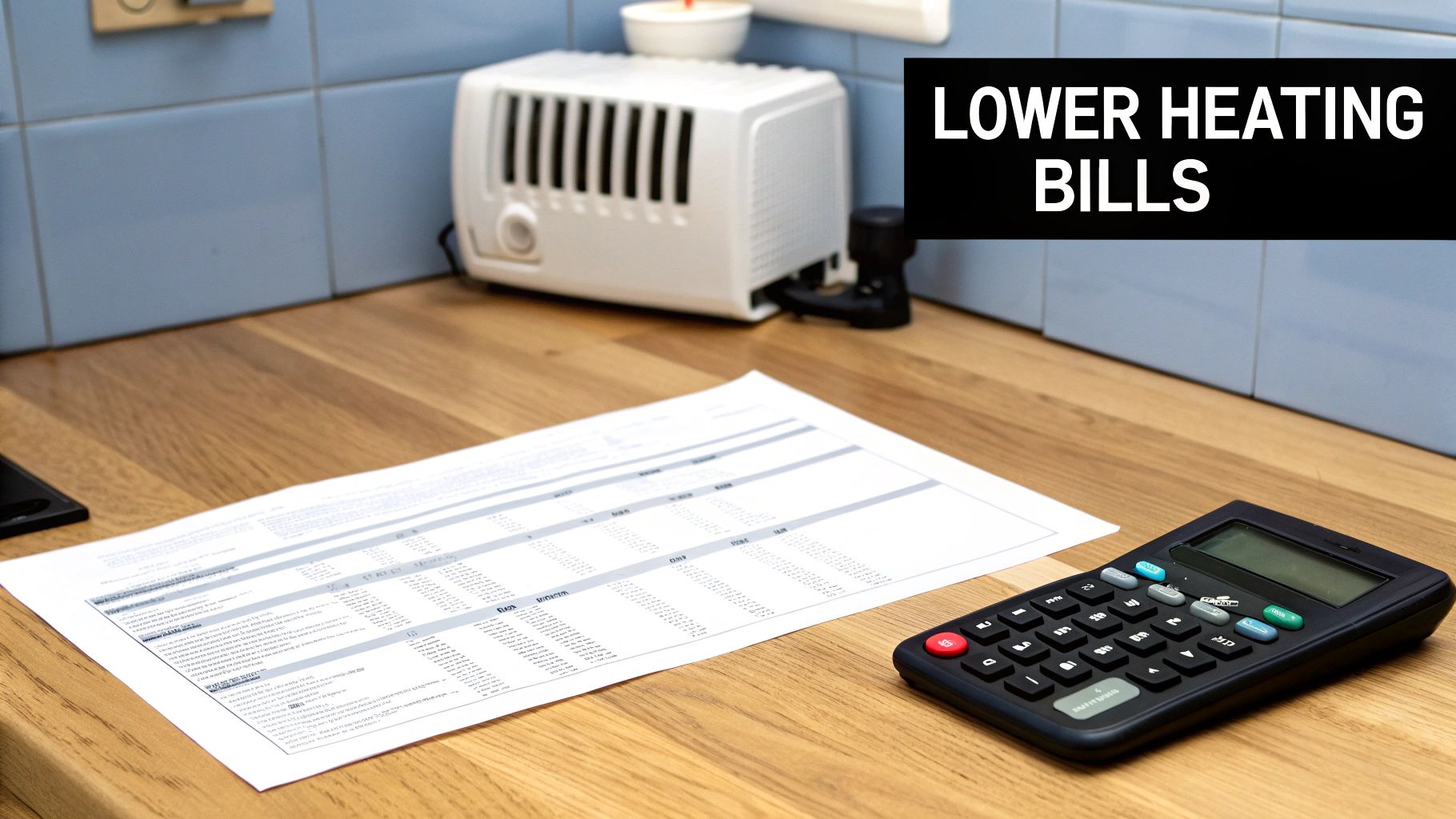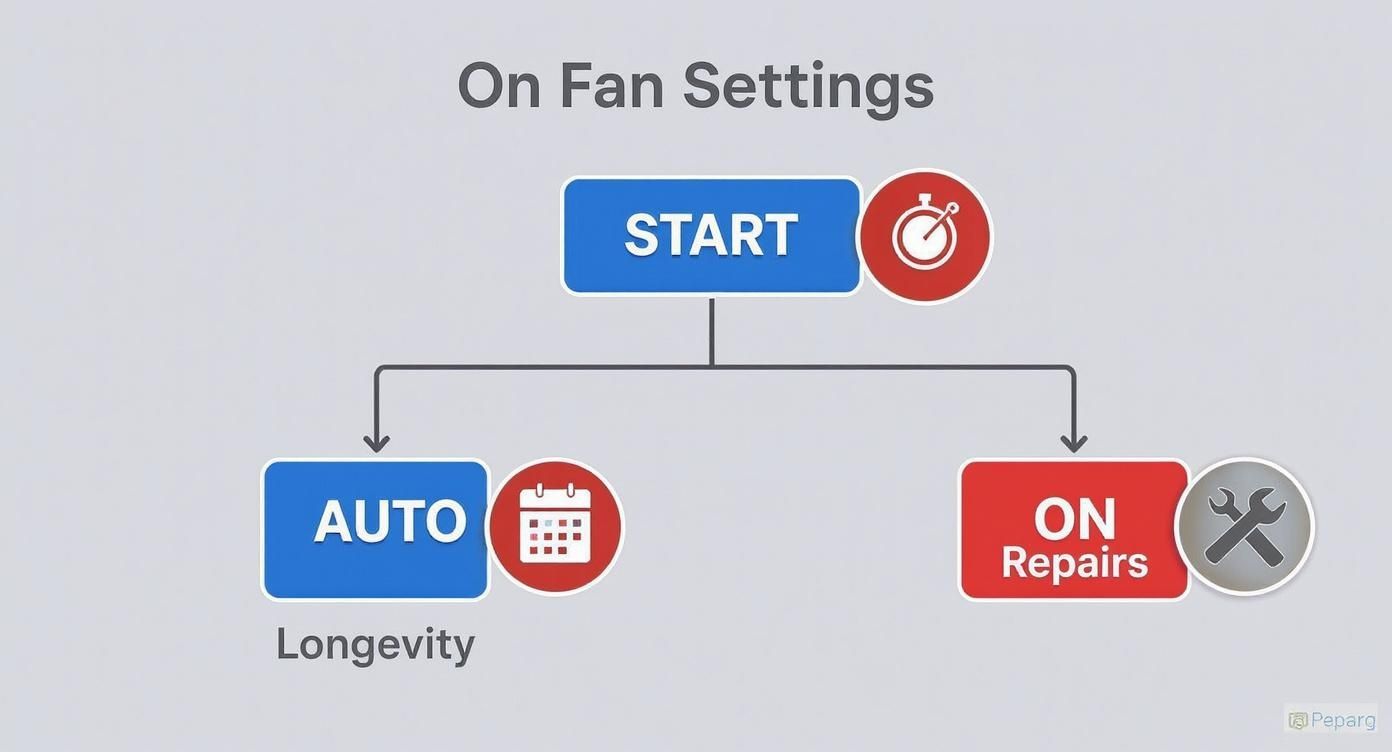Thermostat Fan On Or Auto In Winter Definitive Guide
- shawncovenantaire
- 18 hours ago
- 10 min read
When you're trying to decide between setting your thermostat fan to On or Auto in the winter, the Auto setting is almost always the smarter move for saving energy and money. With this setting, the fan only kicks in when your furnace is actively heating, which stops it from running up your electricity bill and blowing cool air around the house.

Quick Comparison For Fan On Or Auto In Winter
Choosing the right fan setting is a simple tweak that can make a big difference in your home's comfort and heating costs. While leaving the fan On gives you constant air circulation, it also means a higher electric bill and can surprisingly make rooms feel a bit chilly. This happens because the fan keeps running even when the furnace isn't firing up, pushing unheated air through your vents.
On the other hand, the Auto setting syncs the fan directly with your furnace's heating cycles. It's a much more efficient approach, ensuring air only moves when it's being warmed. This simple change prevents drafts and cuts down your energy use significantly. For most homes, this is the sweet spot between comfort and efficiency.

Key Differences Between Fan Auto And On Settings
To help you decide at a glance, this table breaks down the main trade-offs between each setting. It's a quick side-by-side view of how each one impacts your energy use, comfort, and HVAC system.
Feature | Fan Auto Setting | Fan On Setting |
|---|---|---|
Energy Use | Low; fan runs only during heating cycles | High; fan runs continuously |
Comfort | Prevents drafts of cool air | Evens out temperatures but can cause drafts |
Air Quality | Filters air only when heating | Provides constant air filtration |
Equipment Wear | Less strain on the blower motor | Increased wear from constant operation |
Ultimately, the best choice depends on what you prioritize, but the differences are pretty clear.
For the average homeowner, the Auto setting provides the most practical benefits. It aligns fan operation with actual heating needs, directly translating to lower energy bills and reduced wear on your HVAC system without sacrificing essential comfort.
Understanding Fan On And Auto Settings
Before you can decide between running your thermostat's fan on On or Auto this winter, you need to get a handle on how each setting actually works. They operate on completely different principles, and that difference has a real impact on everything from your energy bill to the air you breathe. Making the right call starts with knowing what’s happening behind the scenes.
Think of the Auto setting as your fan’s default, energy-saving mode. It perfectly syncs the furnace's blower fan with the heating cycle. When the furnace kicks on to heat your home, the fan runs to push that warm air through the vents. The moment your home hits the set temperature, both the furnace and the fan shut off. Simple and efficient.
How Each Setting Works
The On setting is a totally different story. It basically decouples the fan from the heating cycle, forcing it to run continuously, 24/7. It doesn’t matter if the furnace is firing up or sitting idle, that fan is always moving air through your ductwork.
The core difference comes down to control. Auto links the fan to your furnace's heating cycles, while On provides non-stop airflow no matter what. This is the main reason you'll see big variations in energy use, comfort, and air quality between the two.
Many newer smart thermostats also throw a third option into the mix: Circulate. This setting is the middle ground. It runs the fan for a set number of minutes each hour (say, 15 minutes every 60 minutes), giving you some of the air-mixing benefits of the On setting without the full-time energy cost. You can learn more about how the auto setting optimizes your system in our detailed guide on what "auto" means on a thermostat.
At the end of the day, each setting has its purpose. Choosing Auto is all about maximizing energy efficiency. Opting for On prioritizes constant air circulation and filtration. And Circulate? It tries to give you a little bit of both.
Evaluating Energy Use And Costs

Let's be honest, for most of us, the decision between thermostat fan on or auto in winter comes down to one thing: the bottom line. How much is this going to cost me? The difference between these two settings isn't pocket change, it directly ties into how many hours your furnace's blower motor runs every single day.
Setting your fan to Auto is the simplest path to energy savings. The fan motor, a component that can draw anywhere from 200 to 800 watts depending on its age and efficiency, only kicks on when the furnace is actively heating. This approach perfectly syncs energy use with your actual heating needs, eliminating any waste.
On the flip side, the On setting means your blower runs 24/7. This constant operation can sneakily add a significant amount to your monthly electricity bill, even when the furnace isn't burning fuel. That continuous power draw really adds up over a long winter.
Calculating The Cost Difference
Let's run some real numbers. A pretty standard furnace fan using 400 watts running non-stop (On mode) eats up 9.6 kilowatt-hours (kWh) per day. If your electricity rate is around $0.17 per kWh, you’re looking at roughly $49 a month, just for the fan.
Now, let’s switch that same fan to Auto. It might only need to run for a few hours each day, maybe six, depending on how well-insulated your house is and how cold it is outside. Suddenly, that monthly cost plummets to just $12. It’s a simple flick of a switch that could save you a decent amount of cash month after month.
One of our clients in a moderately cold area was shocked to find that switching from On to Auto slashed their winter electricity bill by almost $35 per month. That’s over $100 in savings across the heating season, all without feeling any less comfortable.
The fan's energy consumption is a bigger piece of the HVAC pie than most people realize. In some cases, it can be responsible for up to a third of the system's total energy use when heating demand is low.
To really tackle those high winter bills, you need a multi-pronged approach. You can find more strategies in our guide on how to save on your heating bill. And don't forget the basics, improving your home's thermal efficiency with things like effective window insulation solutions for winter can make a massive difference in how often your furnace has to run in the first place.
Assessing Comfort And Air Quality
Beyond your monthly utility bill, the choice between running your thermostat fan on or auto in winter directly influences your home's overall comfort and air quality. Each setting creates a distinct indoor environment, making it important to match the mode to your family’s needs and your home’s unique layout. The right decision really comes down to balancing even temperatures against potential drafts.
The On setting is fantastic for eliminating hot and cold spots. In multi-level or older, draftier homes, it constantly mixes the air, preventing those chilly pockets from forming on the ground floor or in rooms far from the thermostat. This continuous circulation helps create a more uniform temperature throughout the entire house.
However, this constant airflow has a downside. When your furnace isn’t actively heating, the fan is just circulating unheated, room-temperature air. This can feel like a cool draft, creating a sense of chilliness even if the thermostat reading is stable.
Improving Your Indoor Air
The fan setting you choose also makes a big difference in your home's air quality. Since the fan is what pushes air through your HVAC system’s filter, running it continuously in On mode means you're filtering your air 24/7. This can be a huge benefit for households with allergy sufferers or pets, as it captures far more dust, dander, and other airborne particles.
Of course, this constant filtration means your filters will get dirty much faster, requiring changes as often as every 30 days. If you're looking for even better results, you can explore dedicated air purification systems that work alongside your HVAC unit.
The Auto setting avoids that drafty feeling by only running when the furnace is producing warm air. While more energy-efficient, this can lead to stagnant air and more noticeable temperature swings between heating cycles, especially in poorly insulated homes.
Beyond the HVAC system, other things like your flooring can also play a role in improving indoor air quality with carpet. Ultimately, the best choice depends on whether you prioritize consistent temperatures and maximum air filtration over preventing drafts and saving on filter costs.
How Your Fan Setting Affects System Health And Maintenance
It might not seem like a big deal, but your choice between fan on and auto this winter has a direct impact on the long-term health of your HVAC system. It all comes down to runtime.
Every hour your blower fan runs, it puts a little more wear on the motor and pulls more particles into the filter. This is where the two settings really start to diverge in terms of maintenance and lifespan.
The Hidden Costs of Constant Operation
Keeping the fan on On means the blower motor is working around the clock, day in and day out. This constant operation accelerates wear on critical components like the motor bearings. In fact, this added stress can shorten the motor's lifespan by as much as 20%.
Your air filters also take a beating. Since air is always moving, the filter is always catching dust, dander, and other debris. You'll likely find yourself needing to swap them out every 30 days, rather than every few months.
A little proactive care goes a long way here:
Check motor bearing lubrication and look for wear every 1,000 hours of runtime.
Stick to a strict filter replacement schedule: monthly for On mode, quarterly for Auto.
Following these simple steps can help you sidestep a surprise service call and a hefty repair bill down the road.
The hidden maintenance costs from running your fan constantly can easily wipe out any perceived benefits, making the Auto setting the smarter long-term play for most homeowners.
Projected Lifespan And Filter Costs
Let's put some real-world numbers to this. A typical blower motor running on the Auto setting might last you a solid 10 years. Switch that to On mode, and you could be looking at a replacement in just 8 years.
That two-year difference isn't just an inconvenience; it often comes with a replacement bill of $200 to $400, not including labor.
Filter costs add up, too. Let's say you're buying standard $15 filters.
On Mode: You might go through 4 filters over the winter, costing you $60.
Auto Mode: You’ll probably only need 2 filters, for a total of $30.
As you can see, the maintenance expenses can literally double when the fan runs continuously. To learn more about keeping your system in top shape, check out our HVAC maintenance guide.
By finding the right balance between runtime and proper service, you'll extend the life of your equipment and keep those unexpected costs at bay. A simple logbook to track filter changes and service dates can make a world of difference.
So, Which Setting is Best for Your Home?
Ultimately, deciding between the fan's Auto and On settings comes down to your home's unique layout and your family's priorities. For most people in a standard, well-insulated house, Auto is the hands-down winner. It saves money and keeps you from feeling those chilly drafts when the furnace isn't actively heating.
But there are definitely times when breaking that rule makes sense.
If you’re constantly battling uneven temperatures between floors or have family members with allergies or respiratory issues, running the fan on On can be a game-changer. That continuous airflow does a great job of mixing the air to even out temperatures and ensures your system’s filter is always working to pull contaminants out of the air. For anyone with a newer system, the Circulate mode on a smart thermostat often hits that perfect sweet spot, improving air quality without the non-stop energy drain.
Making the Right Call for Your Situation
This decision tree breaks down how different priorities, like focusing on your system's longevity versus immediate comfort, can point you to the right setting.

As you can see, sticking with Auto is the best way to protect the long-term health of your HVAC system. Running the fan constantly on On puts more wear and tear on the components, which can lead to more frequent repairs down the road.
The best setting isn't a one-size-fits-all answer; it’s about finding the right balance for your home. You have to weigh your desire for perfectly even temperatures and cleaner air against the reality of higher energy bills and increased system maintenance.
Sometimes, a simple adjustment can have surprising results. One homeowner, for instance, found that increasing the fan speed on their heat pump actually slashed their energy use by 30-50% while pumping out more heat. Knowing how to program a thermostat effectively is the key to unlocking these kinds of savings and truly tailoring your system's performance to your home.
Common Questions About Fan Settings in Winter
Even after weighing the pros and cons, a few specific questions always seem to pop up when homeowners are deciding between thermostat fan on or auto in winter. Let's clear up some of the most common ones so you can feel confident in your choice.
Does Running The Fan On In Winter Damage My Furnace?
It won't directly damage the furnace, no. But, it does keep the blower motor running nonstop, which can definitely accelerate wear and tear on components like the motor bearings. Think of it like putting extra miles on your car, this added strain can shorten the component's lifespan and potentially lead to higher maintenance costs down the road.
Will Using The On Setting Help Heat My Basement?
Absolutely. The constant air circulation you get from the On setting is fantastic for mixing the air in your home. It does a great job of pushing that warmer air downstairs and reducing those chilly spots you often find in basements or on lower floors. Just be ready for a bump in your electricity bill.
A great middle-ground solution is the Circulate mode found on many smart thermostats. It gives you the best of both worlds by running the fan for set periods, like 15 minutes each hour, improving air mixing and filtration without the full-time energy drain of the On setting.
One last thing: if you do opt for continuous fan operation, you'll need to be more diligent about your air filter. Plan on swapping it out about every 30 days to keep things running smoothly.
For expert advice on getting the most out of your HVAC system in Arizona's climate, you can always trust the certified technicians at Covenant Aire Solutions. Schedule your consultation today!
